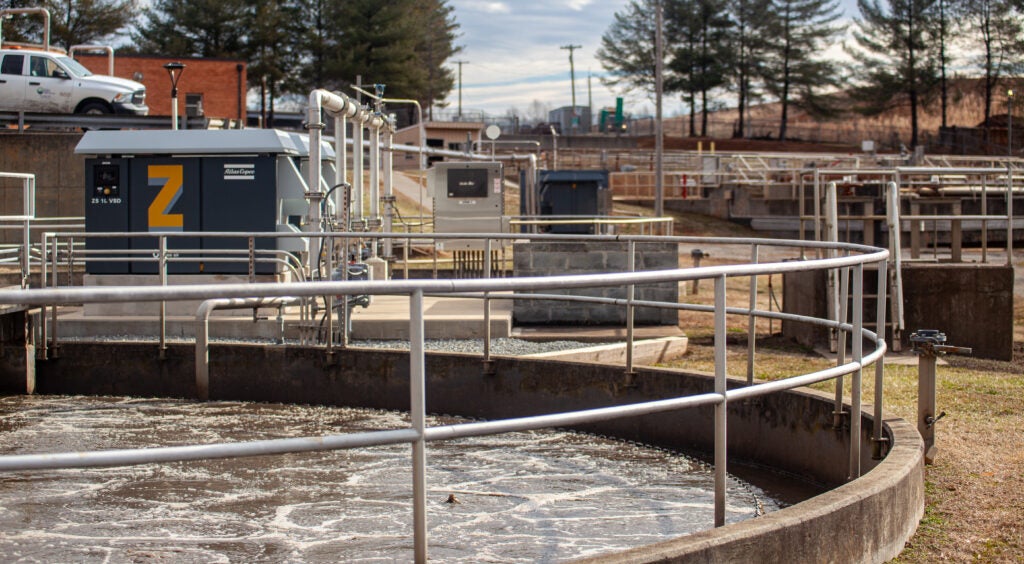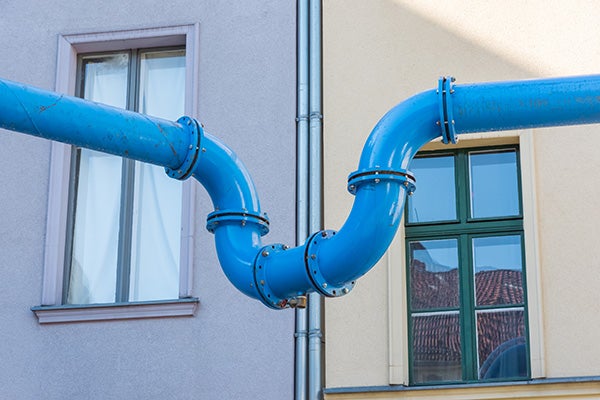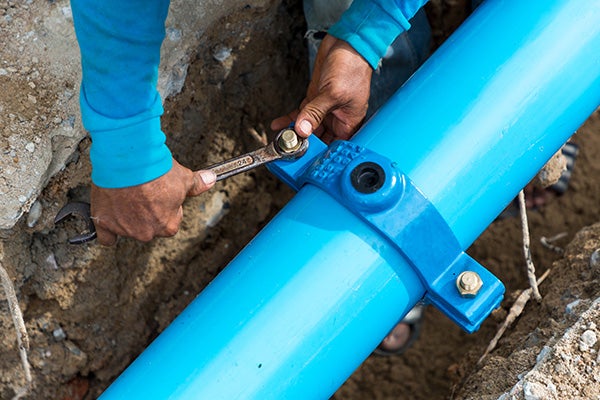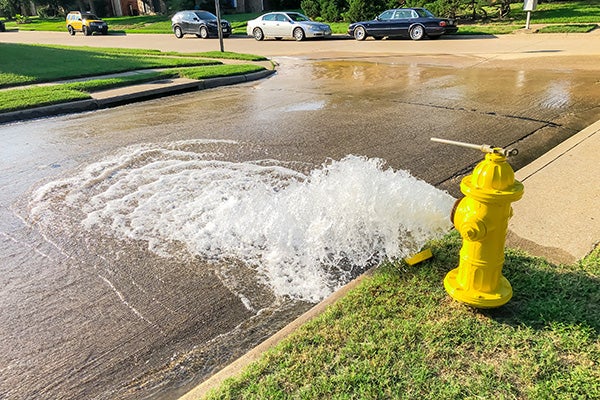Wastewater Treatment

We don’t just supply Bedford with clean water. We also take it away.

Whose Pipe Is It
Do you know who is responsible for your pipes and drains? If so, this guide will come in handy.
Frequently Asked Questions
What is wastewater?
Types of wastewater include:
Domestic wastewater: Water that comes from residential toilet flushing, bathing, dishwashing, clothes washing, etc.
Commercial wastewater: Includes the same type of used water as domestic, but usually in larger quantities, such as that which comes from schools, campgrounds, and restaurants.
Industrial wastewater: Wastewater that comes from industry, such as chemical plants, paper mills, metal fabricators, breweries, etc. Industrial wastewater usually has very high concentrations of organic matter, nutrients, toxic chemicals, and possibly high temperatures.
Typically, industrial wastewater must receive some level of treatment before it is released into the sewer system. The Bedford Regional Water Authority works with local industries through its Industrial Pretreatment Program to ensure the wastewater meets strict requirements.
What is a wastewater system?
It’s a network of pipes that collect and transport wastewater from domestic, commercial, and industrial sources to a Wastewater Treatment Plant or another location for disposal.
There are three types of systems: Sanitary Sewer System, Storm Sewer, and Combined Sewer System.
Sanitary Sewer Systems directly transport domestic, commercial, and industrial wastes to a wastewater treatment plant. This is the type of system the Bedford Regional Water Authority operates and maintains.
Storm Sewers, also called Surface Sewers, direct the water from rain and snowmelt off of roofs and roads into manholes, pipes, ditches, and channels that will eventually lead to creeks, streams, rivers, etc. without any treatment.
Combine Sewer Systems combine the sanitary and storm systems, then transports the waste to a wastewater plant. These are not ideal as most plants are not equipped to handle this large amount of flow.
Are different types of drainage pipes used?
Yes, there are 3 different types: Private Drains, Lateral Drains, and Public Sewage Systems.
Private Drains serve a single property but are located outside of the property’s boundaries.
Lateral Drains serve a single property but are located outside of the property’s boundaries.
Public sewage systems serve more than one property. All types could be installed on private property, footpaths, public roads, gardens, or other public spaces. All drains and sewers can be designed to work as a combined or separate system.
We own and maintain public sewers. They are typically displayed on public sewer maps, which are available upon request.
How do we collect wastewater?
We maintain a network of around 200 miles of underground pipes that collect wastewater from homes and businesses in Bedford County. The wastewater flows by gravity to a wastewater plant or flows by gravity to a lift station where it is then pumped to the wastewater plant.
How is wastewater treatment quality monitored?
Each wastewater plant is issued a permit from the Virginia Department of Environmental Quality that outlines the parameters that the plant must meet. Routine testing and sampling allow for information to be collected that informs us of how well our plants are operating.
We sample the quality of our discharges in collaboration with the Virginia Department of Environmental Quality, and the results are sent to them and published in a public register.
What happens to the “sludge” from a sewage system?
The waste sludge mentioned previously that is produced by the plant process must also be disposed of. This waste sludge, also known as biosolids, is created through the breakdown of organics by microorganisms. There are strict rules for disposing of biosolids.
Biosolids can be recycled into usable commodities such as soil enhancement, topsoil substitute, etc. Biosolids can also be spread on farmland. This is only allowed if both the biosolids and soil meet requirements set by the Virginia Department of Environmental Quality.
Sewage sludge may also be incinerated. Although a large amount of the produced ash is recycled, some must be disposed of in landfills.
How do you manage environmental concerns?
Our goal is to prevent environmental concerns like insects, odor, and noises; and when undertaking a new project, we take into the effects on those who live nearby. We are also implementing improvements to provide extra wastewater treatment capacity in order to comply with the Virginia Department of Environmental Quality regulations and meet waterway quality objectives.
How do we treat wastewater?
Wastewater Treatment Process
We operate five wastewater treatment plants, which are responsible for processing projected sewage volumes and meet the Virginia Department of Environmental Quality regulations.
Preliminary Treatment
In the plants, wastewater flows through a series of channels and basins where it is exposed to physical, biological, chemical processes that clean the water. Preliminary treatment is the first stage of treatment designed to remove larger solids. The initial screening process removes debris such as rags, wood, food wrappers, mop heads, roots, etc.
The water then moves into a finer screening process that removes grit, eggshells, sand, coffee grounds, etc.
Primary Treatment
Primary treatment is the second stage of the process. The flow of the wastewater is slowed down to allow for organic, and inorganic floatable solids to settle out. The slower the water flows, the more solids settle out. The solids from this process is generally pumped to a waste tank or digester, and the cleaner water continues to flow to the next process.
Secondary Treatment
Secondary treatment is the next stage in the process. The water is now exposed to bacteria and other organisms that actually eat the organic solids that remain in the water. This process mimics that which occurs naturally in the environment; however, the wastewater plant can produce more bacteria which allows for large amounts of wastewater to be treated at a faster rate. While the solids are being consumed by the bacteria and organisms, more solids are actually being produced due to the large amounts of organisms and the associated solids that result from the process.
These solids are also settled out by slowing the flow of the water again. Some of these solids are returned to the beginning of the treatment process where they will meet with fresh wastewater that is entering. Extra solids that are not needed are pumped to a waste tank or digester. The much cleaner water now is allowed to flow out.
Tertiary Treatment
Tertiary treatment is not available in every wastewater plant but has been added in the more recent years to help with more stringent removal. This process usually involves a type of finer filtration to remove even more suspended solids and can aid in nitrogen, and phosphorus removal. The filtration unit is usually composed of sand, or membrane filtration.
Disinfection
Disinfection is the last stage of the process. The wastewater that has been cleaned could still contain pathogens that could be detrimental to human health. Not all of the organisms will be settled or filtered out. Chemicals, such as chlorine gas, or sodium hypochlorite (bleach) may be used to kill any remaining organisms in the water. If this process is utilized, then the water must be dechlorinated before it can be released back into the environment. The same chemicals that kill pathogens can also kill aquatic organisms, like fish. Chemicals, such as sulfur dioxide, or sodium bisulfite may be used.
Some plants utilize ultraviolet disinfection, in which the water flows through a system of ultraviolet lights that sterilize the organisms. This will halt their reproductive cycle. The water is then discharged to a receiving stream, creek, or river that has been designated to that wastewater plant through the Virginia Department of Environmental Quality.
Reintroducing Water into the Environment
It is vital to our environment that the water we clean be safely returned to the rivers and sea. Many of our rivers are cleaner now than they have been in the last century. This is because we have been working to renovate and modernize our region’s wastewater treatment plants. The water we discharge should be as clean or cleaner than what already exists.


